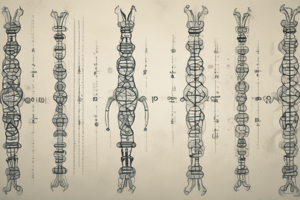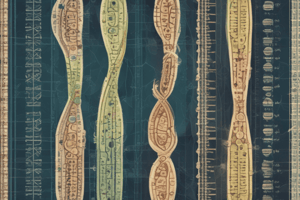Podcast
Questions and Answers
What is a nondisjunction?
What is a nondisjunction?
An error in cell division that causes homologous chromosomes or sister chromatids to move to the same side of the dividing cell.
When can nondisjunction occur? Choose the best answer.
When can nondisjunction occur? Choose the best answer.
- Only in mitosis
- Only in meiosis II
- In meiosis I, mitosis, or meiosis II (correct)
- Only in meiosis I
Which syndrome is characterized by the XO chromosome abnormality?
Which syndrome is characterized by the XO chromosome abnormality?
Turner syndrome
What kind of cell results when a diploid and a haploid gamete fuse during fertilization?
What kind of cell results when a diploid and a haploid gamete fuse during fertilization?
Of the following chromosomal abnormalities, which type is most likely to be viable in humans?
Of the following chromosomal abnormalities, which type is most likely to be viable in humans?
If a diploid cell undergoes meiosis and produces two gametes that are normal, and one with n − 1 chromosomes, and one with n + 1 chromosomes, what type of error occurred?
If a diploid cell undergoes meiosis and produces two gametes that are normal, and one with n − 1 chromosomes, and one with n + 1 chromosomes, what type of error occurred?
If a diploid cell undergoes meiosis and produces two gametes with n + 1 chromosomes and two gametes with n− 1 chromosomes, what type of error occurred?
If a diploid cell undergoes meiosis and produces two gametes with n + 1 chromosomes and two gametes with n− 1 chromosomes, what type of error occurred?
What is a telomere?
What is a telomere?
In E. coli, which enzyme catalyzes the elongation of a new DNA strand in the 5' → 3' direction?
In E. coli, which enzyme catalyzes the elongation of a new DNA strand in the 5' → 3' direction?
Which of the following results in a situation in which the chromosome number is either 2n+1 or 2n-1?
Which of the following results in a situation in which the chromosome number is either 2n+1 or 2n-1?
DNA during interphase exists as chromatin and is less condensed than mitotic chromosomes.
DNA during interphase exists as chromatin and is less condensed than mitotic chromosomes.
What results if a fragment of a chromosome breaks off and then reattaches to the original chromosome at the same place but in the reverse direction?
What results if a fragment of a chromosome breaks off and then reattaches to the original chromosome at the same place but in the reverse direction?
The leading and the lagging strands differ in that ____.
The leading and the lagging strands differ in that ____.
What is meant by the description 'antiparallel' regarding the strands that make up DNA?
What is meant by the description 'antiparallel' regarding the strands that make up DNA?
What is the function of topoisomerase?
What is the function of topoisomerase?
In a DNA double helix, an adenine of one strand always pairs with a(n) _____ of the complementary strand, and a guanine of one strand always pairs with a(n) _____ of the complementary strand.
In a DNA double helix, an adenine of one strand always pairs with a(n) _____ of the complementary strand, and a guanine of one strand always pairs with a(n) _____ of the complementary strand.
After DNA replication is completed, _____
After DNA replication is completed, _____
The first step in the replication of DNA is catalyzed by _____.
The first step in the replication of DNA is catalyzed by _____.
The action of helicase creates _____.
The action of helicase creates _____.
Why is the new DNA strand complementary to the 3' to 5' strands assembled in short segments?
Why is the new DNA strand complementary to the 3' to 5' strands assembled in short segments?
The synthesis of a new strand begins with the synthesis of a(n) _____.
The synthesis of a new strand begins with the synthesis of a(n) _____.
An old DNA strand is used as a _____ for the assembly of a new DNA strand.
An old DNA strand is used as a _____ for the assembly of a new DNA strand.
One possible result of chromosomal breakage is for a fragment to join a nonhomologous chromosome. What is this alteration called?
One possible result of chromosomal breakage is for a fragment to join a nonhomologous chromosome. What is this alteration called?
If cell X enters meiosis, and nondisjunction of one chromosome occurs in one of its daughter cells during meiosis II, what will be the result at the completion of meiosis?
If cell X enters meiosis, and nondisjunction of one chromosome occurs in one of its daughter cells during meiosis II, what will be the result at the completion of meiosis?
What is the function of helicase in DNA replication?
What is the function of helicase in DNA replication?
How does the enzyme telomerase meet the challenge of replicating the ends of linear chromosomes?
How does the enzyme telomerase meet the challenge of replicating the ends of linear chromosomes?
What is a major difference between eukaryotic DNA replication and prokaryotic DNA replication?
What is a major difference between eukaryotic DNA replication and prokaryotic DNA replication?
Eukaryotic telomeres replicate differently than the rest of the chromosome. This is a consequence of which of the following?
Eukaryotic telomeres replicate differently than the rest of the chromosome. This is a consequence of which of the following?
What provides the energy for the polymerization reactions in DNA synthesis?
What provides the energy for the polymerization reactions in DNA synthesis?
Short segments of newly synthesized DNA are joined into a continuous strand by ____.
Short segments of newly synthesized DNA are joined into a continuous strand by ____.
Why is the new DNA strand complementary to the 3' to 5' strands assembled in short segments?
Why is the new DNA strand complementary to the 3' to 5' strands assembled in short segments?
The synthesis of a new strand begins with the synthesis of a(n) ____.
The synthesis of a new strand begins with the synthesis of a(n) ____.
If a diploid cell undergoes meiosis and produces two gametes with n + 1 chromosomes and two gametes with n− 1 chromosomes, what type of error occurred?
If a diploid cell undergoes meiosis and produces two gametes with n + 1 chromosomes and two gametes with n− 1 chromosomes, what type of error occurred?
Flashcards are hidden until you start studying
Study Notes
Nondisjunction and Chromosomal Abnormalities
- Nondisjunction is an error in cell division leading to homologous chromosomes or sister chromatids migrating to the same side.
- Nondisjunction can occur in meiosis I (failure of homologous chromosomes to separate) or in meiosis II/mitosis (failure of sister chromatids to separate).
- Turner syndrome is characterized by an XO chromosome pattern, indicating one X chromosome and no Y chromosome.
- Viable chromosomal abnormalities in humans primarily include certain trisomies such as Down syndrome (trisomy 21).
Gametes and Chromosomal Fusion
- A diploid and haploid gamete fusion results in a triploid cell, which contains three sets of chromosomes.
- Nondisjunction in meiosis II produces gametes with normal chromosomes (n) as well as gametes with n-1 and n+1 chromosomes.
- Nondisjunction in meiosis I results in two n+1 and two n-1 gametes, indicating both members of a homologous pair moved to the same pole.
DNA Structure and Replication
- Telomeres are the protective ends of linear chromosomes.
- DNA polymerase III is the enzyme responsible for elongating a new DNA strand in the 5' to 3' direction.
- Aneuploidy results in a chromosome number of either 2n+1 or 2n-1.
- During interphase, DNA exists as less condensed chromatin compared to mitotic chromosomes.
DNA Changes and Synthesis
- A chromosomal fragment reattaching in reverse direction results in an inversion.
- Leading strands are synthesized in the same direction as the replication fork, while lagging strands are synthesized in the opposite direction.
- Antiparallel strands in DNA refer to the opposite 5' to 3' orientations of the two strands.
- Topoisomerase relieves strain ahead of the replication fork during DNA unwinding.
DNA Replication Processes
- The completion of DNA replication results in each double helix consisting of one old and one new strand.
- The first step in DNA replication is catalyzed by helicase, which unwinds the double helix.
- Helicase creates replication forks and bubbles, facilitating access to the DNA strands.
- Short segments of newly synthesized DNA are joined into a continuous strand by ligase.
Enzymes and Mechanisms in DNA Synthesis
- DNA polymerase can only synthesize DNA in the 5' to 3' direction, requiring segments during the lagging strand assembly.
- RNA primers are essential for the initiation of new strand synthesis, complementary to existing DNA strands.
- An old DNA strand serves as a template for assembling a new DNA strand.
Telomere Replication and Energetics
- Telomerase extends telomeres, preventing their shortening during DNA replication.
- Eukaryotic DNA replication is characterized by multiple origins, contrasting with prokaryotic DNA replication, which has a single origin.
- Eukaryotic gaps at the 5' end of the lagging strand result in unique telomere replication challenges.
- Deoxyribonucleotide triphosphate substrates provide the necessary energy for DNA polymerization reactions.
Studying That Suits You
Use AI to generate personalized quizzes and flashcards to suit your learning preferences.




